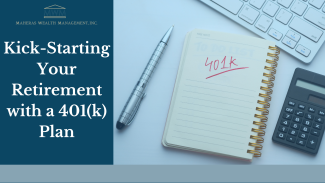
Kick-Starting Your Retirement with a 401(k) Plan
Take control of your retirement planning with a defined contribution plan
The 401(k) pension plan, named after that section of the Internal Revenue Service Code that created it, has become one of the most popular retirement plans in the market. (A similar plan, the 403(b), is often available to employees of certain non-profit organizations, educational institutions, and certain other state or political subdivisions.)
These plans are referred to as defined contribution plans, because each plan participant makes contributions to the plan and has his or her own account balance. The ultimate retirement benefit will depend on the amount of contributions made to the plan and the investment performance of those contributions over the period of participation.
So, Where’s the Kick?
The “kick” comes from the ability to receive tax deferral on both contributions and earnings. Subject to certain limitations, contributions to a 401(k) plan are typically made on a pre-tax basis, which means that money going into the plan will be deducted from your salary before income taxes are calculated. Consequently, by lowering taxable salary, you would pay less income tax during each year of participation.
In many plans, employees can also make after-tax contributions (again, subject to certain limitations). While these contributions would not lower your current year’s income tax, both pre-tax and after-tax contributions will accumulate investment earnings on a tax-deferred basis. You will generally pay income taxes when you make withdrawals, usually at retirement when you may be in a lower tax bracket. Withdrawals prior to age 59½ may have limited availability and, if available, may be subject to a 10% federal income tax early withdrawal penalty. Withdrawals of after- tax contributions will not be taxed.
Employer Matching and Vesting
Moreover, employers can, at their discretion, match employee contributions. For example, a $1 match by your employer for each $1 that you contribute would generate a 100% return before investment even begins.
The advantage of matching by the employer usually depends on the level of the match and the employer’s “vesting” requirements. Vesting is generally the employee’s entitlement to the funds in the plan. All employee contributions, and earnings on those contributions, are 100% vested from the start of your participation.
On the other hand, vesting for employer-matching contributions may be based on the length of employment. Under graded vesting, 20% of an employer’s matching contributions could vest after three years of service, with an additional 20% vested for each of the next four years. After seven years of service, the participant would be fully vested.
With cliff vesting, employees could have no vested interest in employer contributions until completing five years of service, when they immediately become 100% vested.
But Wait, There’s More…
There are several other attractive features of 401(k) plans. You determine how much to contribute and you select how to invest contributions, subject to IRS limitations and the limitations of the plan. If you should leave your place of employment, you would have the right to leave the account, take the entire vested amount with you, or roll it over into another qualified plan. Also, regular investing is made easy through automatic deductions from your paycheck.
Finally, some companies permit hardship distributions from 401(k) accounts. Withdrawals are subject to taxation, and a 10% federal income tax penalty may apply to withdrawals prior to age 59½. This option may be very helpful for medical emergencies, or for special needs. Loans may also be available from these plans.
Tax-deferred investing through an employer-sponsored plan may be a great way to “kick-start” your retirement savings program. When combined with other investments and expected benefits from Social Security, you may establish a level of financial independence consistent with your retirement objectives.
Talk to your financial professional if you have any questions about your 401(k).
Important Disclosures
This material was created for educational and informational purposes only and is not intended as ERISA or investment advice. If you are seeking investment advice specific to your needs, such advice services must be obtained on your own separate from this educational material.
Investing involves risks including possible loss of principal. No investment strategy or risk management technique can guarantee return or eliminate risk in all market environments.
This information is not intended to be a substitute for specific individualized tax advice. We suggest that you discuss your specific tax issues with a qualified tax advisor.
This article was prepared by AdviceIQ.
LPL Tracking #1-05306507

